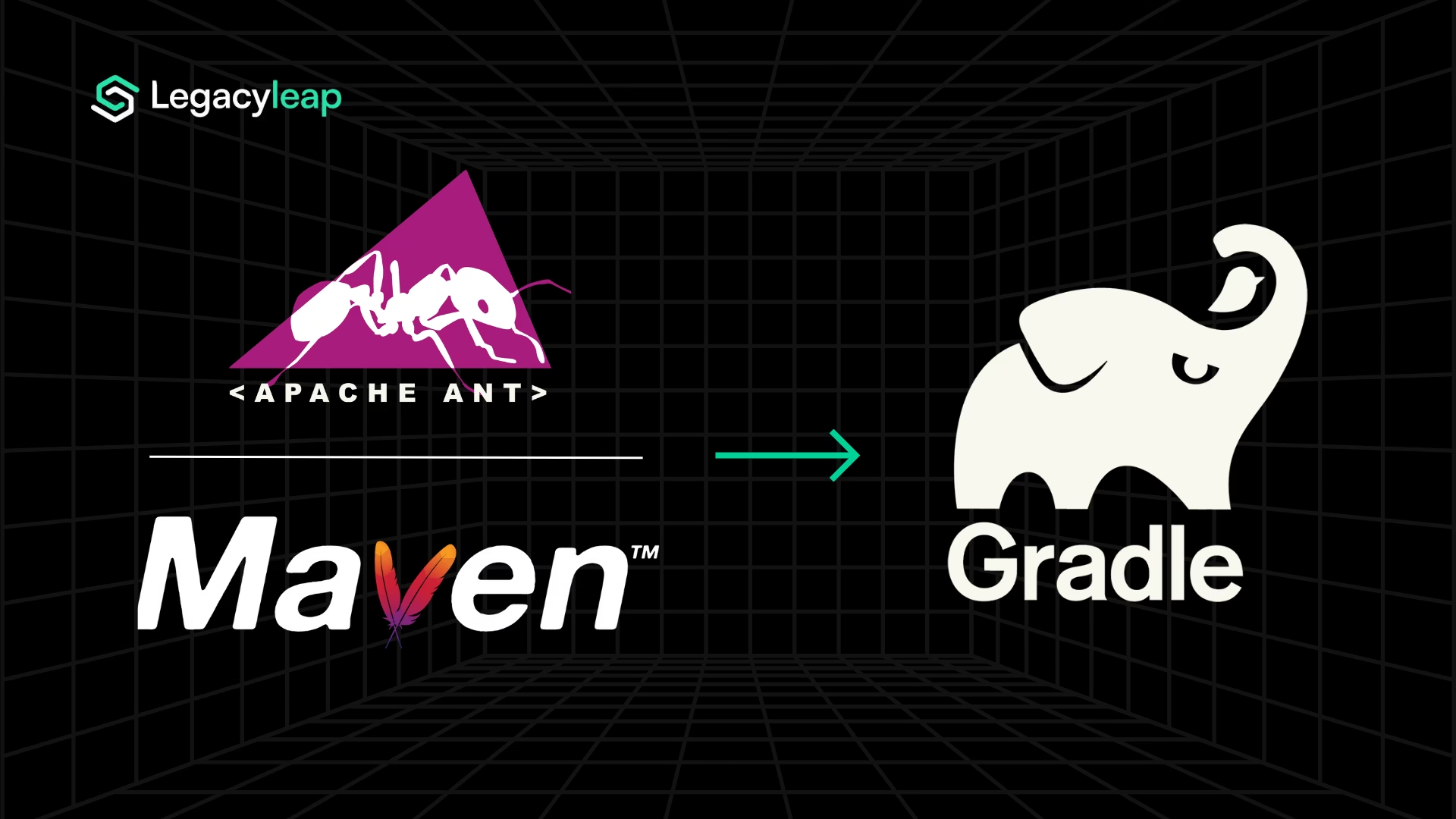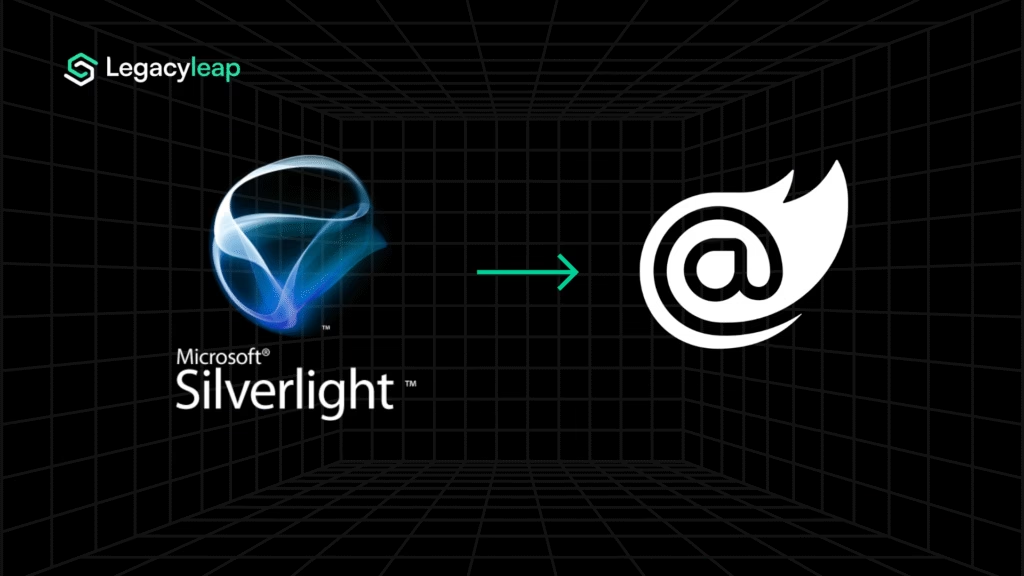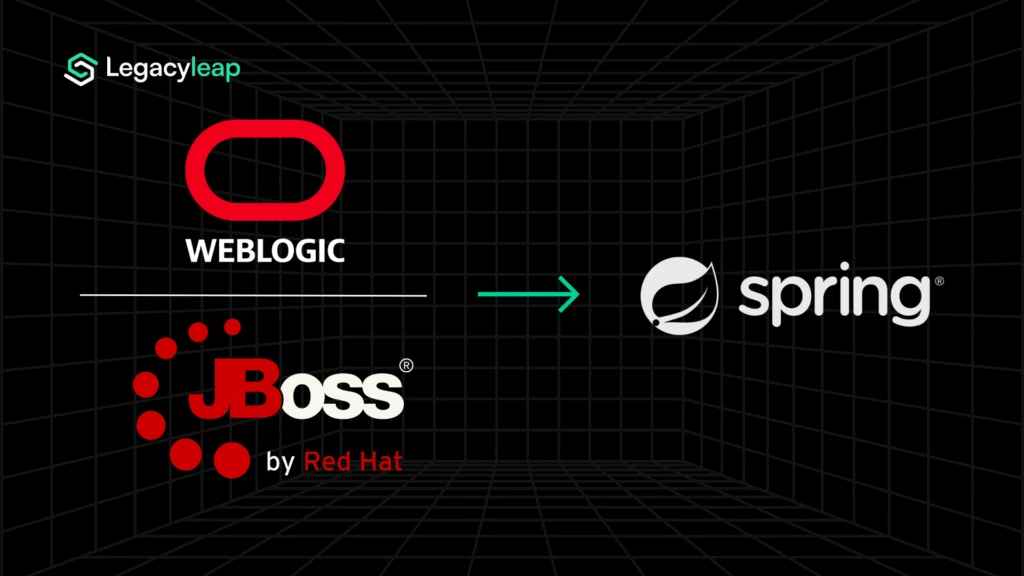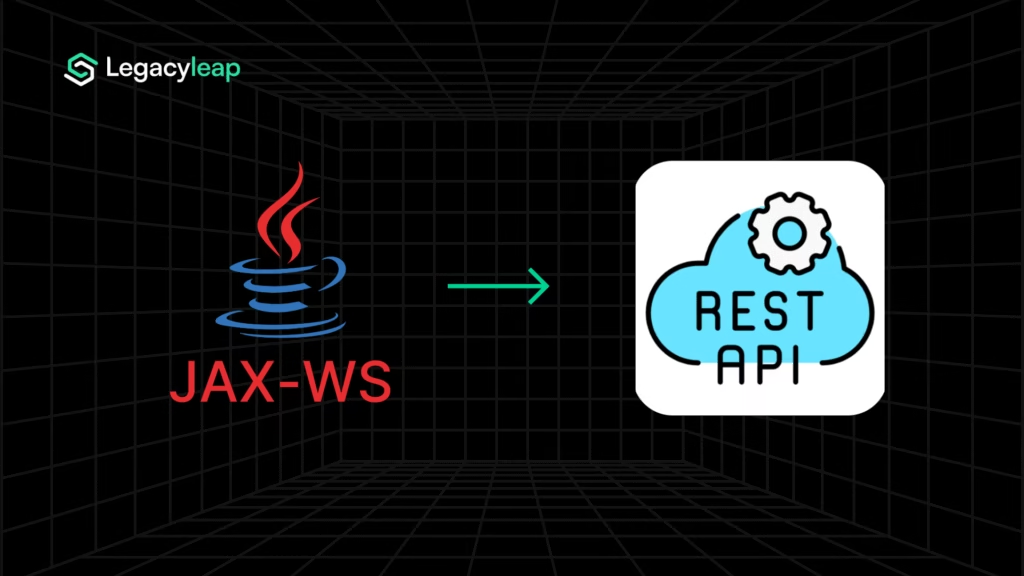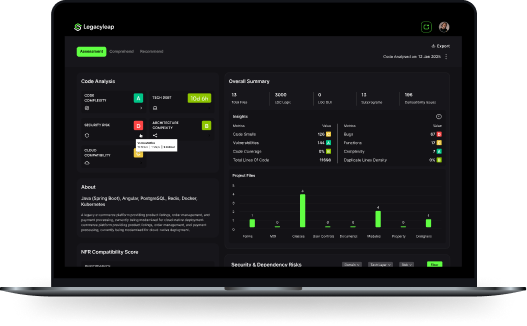Introduction: Why Teams Are Moving Beyond Ant and Maven in 2026
For years, Ant and Maven powered Java builds. They were dependable for monolithic apps and simple pipelines, but today’s engineering landscape is far more complex. Enterprises now operate multi-module systems, containerized deployments, and CI/CD-driven delivery with distributed ownership across teams.
In this environment, Ant and Maven fall behind. For many enterprises, migrating from Ant/Maven to Gradle CI/CD efficiency is now a pressing need, because legacy XML-driven builds slow down pipelines that are expected to run at modern delivery velocity.
XML-heavy configs slow iteration, plugins become brittle at scale, and every new dependency or module increases build fragility. Build times rise, reproducibility drops, and pipelines grow harder to maintain.
Gradle solves these constraints. Its DSL-based configuration, aggressive caching, parallel execution, and CI/CD alignment make it a better fit for cloud-first, modular architectures.
The shift is about enabling faster pipelines, reproducible builds, and modern development velocity. But migrating at enterprise scale requires precision: every dependency, plugin, and build behavior must match the original.
This blog breaks down why enterprises are migrating from Ant/Maven to Gradle, what actually improves, the key challenges in migrating legacy Ant/Maven builds, and how a structured, automated approach can make the transition safe, predictable, and verifiable.
Gradle vs Ant vs Maven: What Actually Improves
Upgrading from Ant or Maven to Gradle fundamentally improves how engineering teams build, test, and deliver software. Gradle brings flexibility, speed, and automation that older systems can’t match at enterprise scale.
The benefits of migrating from Ant/Maven to Gradle become especially clear in large, multi-team ecosystems where Gradle’s caching, flexible DSL, and CI/CD-first design remove the overhead that Maven builds accumulate over time.
| Capability | Ant (Legacy) | Maven (Legacy) | Gradle (Modern) | Enterprise Impact |
| Configuration Model | Fully manual XML scripts | Convention-based XML | Flexible Groovy/Kotlin DSL | Faster onboarding, clearer CI/CD governance |
| Performance | Slow, no incremental builds | Faster but limited caching | Advanced caching + parallelism | Significantly shorter build and test cycles |
| Plugin Ecosystem | Fragmented | Strong but rigid | Rich, customizable ecosystem | Easier integrations with cloud and DevOps pipelines |
| Multi-Module Builds | Hard to maintain | Better but verbose | First-class support | Simplifies large enterprise codebases |
| Build Reproducibility | Hard-coded | Convention-led but brittle | Deterministic + cacheable | Stable pipelines, predictable releases |
| CI/CD Fit | Poor | Moderate | CI/CD-native | Faster release cycles, fewer failures |
Gradle isn’t just more powerful. It’s operationally aligned with how modern engineering teams work. Build caching reduces repeated computation across teams, remote build execution improves speed for large repos, and declarative DSLs make pipelines easier to govern, audit, and evolve.
For enterprises with sprawling Java estates, Gradle becomes the foundation for scalable, modular, cloud-ready build automation, something Ant and Maven increasingly struggle to provide.
But migrating legacy build logic, plugin configs, and dependency graphs safely requires automation, dependency visibility, and verifiable parity.
Also read: A Complete Java Migration Guide for Modernizing Legacy Enterprise Stacks.
How Ant and Maven Builds Are Migrated to Gradle
Upgrading to Gradle isn’t a simple syntax swap. Each legacy build system has its own structure, configuration patterns, and plugin behaviors that must be mapped cleanly into Gradle’s DSL. At enterprise scale, this demands discipline, parity checks, and clear sequencing.
Ant → Gradle
Ant migrations require transforming procedural XML tasks into Gradle’s declarative build logic. The typical workflow includes:
- Review the Ant build.xml: Identify targets, macros, script tasks, and externalized properties that dictate build flow.
- Map Ant tasks to Gradle equivalents: Java compilation, packaging, resource processing, and custom script execution need to be shifted into Gradle tasks or plugins.
- Convert build logic into Gradle DSL: Procedural Ant steps become declarative Groovy/Kotlin DSL, often consolidating multiple steps into a single Gradle task.
- Replace custom Ant scripts with Gradle plugins: Many Ant capabilities are now covered by stable Gradle plugins, reducing custom logic and improving maintainability.
- Enable caching and incremental builds: Configure Gradle’s build cache, parallel execution, and incremental compilation to achieve performance improvements that Ant cannot provide.
- Validate outputs and artifacts: Confirm JAR/WAR structure, generated files, resource handling, and dependency resolution match Ant’s outputs before switching pipelines.
Maven → Gradle
Maven migrations are more structured, but translating conventions and plugins to Gradle requires careful mapping. Key steps include:
- Analyze the POM structure: Review dependency hierarchies, plugin configurations, modules, profiles, and build extensions.
- Convert dependency scopes: Maven’s compile, runtime, provided, and test scopes must be mapped accurately to Gradle’s configurations.
- Map Maven plugins to Gradle plugins: Common Maven plugins (Surefire, Shade, Compiler, Assembly, JAR) need equivalent Gradle plugins or DSL-based task definitions.
- Handle profiles and environment-specific configurations: Convert Maven profiles into Gradle source sets, conditions, or environment-aware configurations.
- Align multi-module structures: Translate Maven’s hierarchical module layout into Gradle’s settings.gradle and modular project structure.
- Run parity tests to validate the build: Ensure compilation, packaging, test execution, and artifact generation behave identically before replacing the Maven build in CI/CD.
Ant/Maven Migration Challenges and Strategies
Migrating from Ant/Maven to Gradle CI/CD efficiency is a structural change in how builds are organized, optimized, and governed. Once the mechanical steps of translation are understood, the real challenges emerge at the architectural, dependency, and pipeline levels.
Key challenges include:
- Build-script re-architecture, not just conversion: XML → DSL translation is easy. Recreating build logic in Gradle’s declarative model (tasks, lifecycle hooks, source sets) requires architectural clarity that many legacy builds never had.
- Plugin compatibility and behavior differences: Legacy Maven plugins (Surefire, Shade, Assembly) or Ant scripts often behave differently in Gradle. Equivalent plugins must be chosen, configured, and validated to preserve the original build behavior.
- Dependency and scope mapping across systems: Maven’s scopes and Ant’s manually declared dependencies don’t map 1:1 to Gradle configurations. Incorrect mapping leads to runtime errors, classpath issues, or missing artifacts.
- Multi-module alignment and project restructuring: Large enterprises depend on parent POMs or Ant include patterns. Migrating these to Gradle’s settings.gradle model requires restructuring modules, normalizing build logic, and aligning shared configurations.
- Pipeline continuity and test coverage gaps: Builds feed into CI/CD. Any mismatch in tests, artifact structure, or environment-specific behavior disrupts pipelines. Many legacy systems lack sufficient test coverage to validate changes reliably.
Proven enterprise strategies:
- Incremental migration with a pilot module: Convert one representative module end-to-end before scaling. This creates templates, validates plugin mappings, and reveals architectural gaps early.
- Hybrid-transition workflows: Gradle can temporarily execute Ant tasks or resolve Maven repositories. This allows phased adoption without destabilizing active builds.
- Pipeline-first modernization: Modernizing CI/CD alongside the Gradle transition ensures reproducible builds, stable testing, and immediate visibility into discrepancies.
How Gen AI Speeds Up Ant/Maven to Gradle Migration
Manual build rewrites absorb enormous engineering time, especially across multi-module repositories with years of accumulated logic. Gen AI changes the workflow by automating comprehension, translation, and validation, turning a manual rewrite into a governed, predictable process.
What Gen AI enables:
- Automated script translation: AI converts Ant’s build.xml or Maven’s POMs into Gradle’s Groovy/Kotlin DSL, mapping tasks, phases, lifecycle hooks, and dependency declarations into modern equivalents.
- Dependency & configuration tracing: AI analyzes entire build graphs, resolving where dependencies originate, how they are scoped, and how they must map into Gradle configurations.
- Plugin re-mapping & recommendations: Instead of manually searching for equivalents, AI evaluates legacy plugins and proposes compatible Gradle plugins, extensions, or DSL-based replacements.
- Parity-validation through automated build runs: AI generates regression builds and test executions to confirm that Gradle build outputs (artifacts, classpaths, tests, resources) behave exactly like the Ant/Maven originals.
This automation reduces manual migration effort by 60–70%, minimizes regressions, and ensures functional parity across the build, packaging, and test layers, enabling teams to adopt Gradle without risking pipeline instability.
Also read: How Can Gen AI Drive Every Step of Your Modernization Journey?
Legacyleap in Action: Verified Build Modernization
Build migrations fail when teams lack visibility into the true complexity of their pipelines. Legacy Ant and Maven builds often contain years of accumulated scripts, hidden dependencies, and plugin behavior that only reveal themselves during production failures.
Legacyleap is built to eliminate that risk. It combines Gen AI automation with compiler-grade validation and enterprise governance to ensure that build modernization is controlled, predictable, and fully verifiable.
How the platform enables safe, accurate Gradle adoption:
- System-wide dependency and plugin analysis: Legacyleap scans every build file (Ant targets, Maven POMs, multi-module hierarchies, plugins, profiles) and constructs a unified dependency map. This establishes complete visibility before any transformation occurs.
- In-enterprise execution for security and compliance: All build transformations, dependency mapping, and DSL generation run inside the client environment. No code leaves the enterprise boundary, ensuring compliance with internal controls and regulatory requirements.
- Human-in-the-loop script governance: AI automates the heavy lifting, but engineers review and validate each converted Gradle script at defined checkpoints. This creates a governed workflow that blends automation with expert oversight.
- End-to-end modernization outputs: Beyond converting scripts, Legacyleap generates Gradle DSL files, CI/CD pipeline integrations, build/test regression suites, and artifact validation reports, enabling seamless adoption into production pipelines.
Measured outcomes:
- 100% dependency visibility before conversion
- 60–70% automation in Ant/Maven → Gradle script refactoring
- 90%+ build and test parity validated through automated regression suites
- 30–50% reduction in build times after Gradle adoption
Also read: Why Legacyleap Is Your AI Companion Platform for Enterprise-Scale Modernization.
Conclusion: A Verified Path to Gradle
Legacy Ant and early Maven builds were designed for a different era, one without containers, multi-module pipelines, or cloud-native deployment models. Today, they slow development cycles, complicate CI/CD adoption, and make large Java estates harder to maintain.
Gradle provides the performance, flexibility, and pipeline alignment modern engineering teams need. But migrating safely requires dependency visibility, plugin accuracy, and verifiable parity across builds and tests.
With Legacyleap’s Gen AI-powered modernization platform, enterprises can transition from Ant or Maven to Gradle with confidence. Every build script is analyzed, refactored, validated, and governed, delivering faster pipelines, cleaner automation, and reduced operational overhead.
Start with a $0 Build Modernization Assessment to map your build files, uncover dependency risks, and get a verified roadmap for adopting Gradle across your engineering ecosystem.
FAQs
Yes. Gradle is designed for high-throughput CI/CD environments. Features like incremental builds, task-level caching, remote build caching, and parallel execution dramatically reduce build and test cycle times. While Maven and Ant rerun most tasks for every pipeline execution, Gradle reuses prior results when possible, cuts redundant work, and optimizes dependency resolution. In large multi-module repositories, enterprises typically see 30–50% faster CI/CD performance after migrating to Gradle.
Yes. Gradle can consume Maven repositories, reuse existing Maven artifacts, and even invoke Ant tasks when needed. This makes hybrid setups possible, allowing teams to migrate incrementally rather than rewriting everything at once. It’s especially useful in multi-team environments where some modules convert to Gradle while others remain on Maven or Ant temporarily.
The main risks involve mismatched plugin behavior, incorrect dependency scope mapping, restructuring multi-module projects, and preserving artifact consistency. Build logic that worked implicitly in Ant or Maven may behave differently in Gradle’s DSL model. Without full dependency visibility and parity testing, teams risk breaking CI/CD pipelines or generating artifacts that diverge from the original builds. Legacyleap mitigates this by providing system-wide dependency mapping, plugin remapping, compiler-validated DSL outputs, and regression build/test validations before any cutover.
Legacyleap validates every converted Gradle script against the legacy builds using AI-generated regression tests, automated build comparisons, and compiler guardrails. It checks classpaths, scopes, artifacts, plugin outputs, test results, and resource handling to ensure the Gradle build behaves exactly like the Ant or Maven version. Engineers review these checkpoints to confirm functional and structural equivalence before pipelines are switched over.
Enterprises typically achieve faster and more predictable pipelines after switching to Gradle. Building caching, parallel task execution, and incremental compilation reduces unnecessary work on both local machines and CI/CD runners. The result is shorter build and test cycles, improved developer feedback loops, and reduced infrastructure load. For most large codebases, teams see 30–50% improvement in build times once Gradle is fully adopted and cache strategies are optimized.


